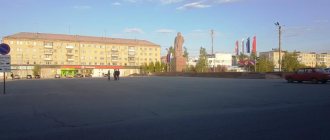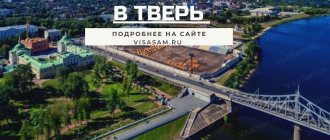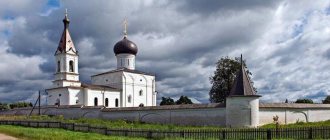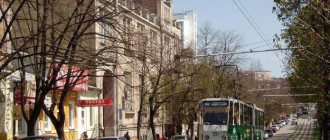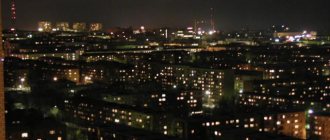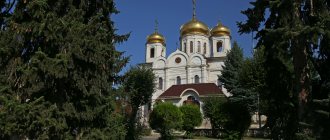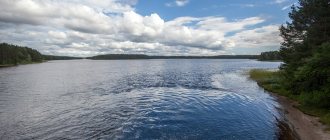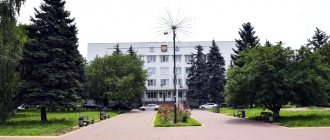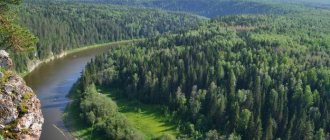More about the districts of the Saratov region here.
Balashov is the largest city in the west of the Saratov region, it is located in the valley of the Khoper River. The city is located 210 km from Saratov. It is located at the intersection of two railway lines, Tambov-Kamyshin and Penza-Povorino.
Buses and minibuses depart from the bus station to neighboring settlements. Not far from the city there is the military town of Balashov-13 and a military airfield.
About the city of Balashov
During the period of the first development of the Saratov region, fugitives from central Russia in the seventeenth century built a small farm on the site of modern Balashov. The peasant Vasily Balashka settled here, then the farm grew into a small village. The city was founded in 1780 , based on a decree of Empress Catherine II.
Empress Catherine II
His specialization was servicing agricultural production. At the beginning of the 19th century, the newly founded city had already become the 10th largest settlement in the Saratov province. It is developing rapidly, becoming an industrial and economic center.
In the 30s of the 19th century, just over 2 thousand people lived here, but by 1859 this number grew to 6600. During this period, a pier was created in the city, used mainly for grain rafting.
Immediately after the reforms of Alexander the Second, a parish school appeared in Balashov. Later, a men's and women's gymnasium, a four-year school, and religious and vocational schools were opened. In 1897, there were 5 schools and 7 churches in the city, and there was a zemstvo hospital.
The merchant class was traditionally responsible for the development of the city's economy. Large fairs were held in Balashov, there were 4 of them - Evdokia, Troitskaya, Rozhdestvenskaya, Ilyinskaya.
Factories were built, and if oil mills, tallow-making and brick production were characteristic of each settlement of the province, the construction of an iron foundry and a mechanical workshop already spoke of the industrial status of the city. There were abundant black soils around the city, and the growing crops were processed in 6 steam mills.
Trade was actively developing; on Trinity Square and the central streets of the city one could see textile, fur, sausage shops, bakeries, confectioneries, and Singer and Ford representative offices.
In 1891, construction of railways passing through Balashov began. After the construction of two lines and the construction of a bridge across the Khoper River, the city began to develop even more actively.
Distillery in Balashov
In 1907, 25 thousand people already lived here. Soviet power in the city was proclaimed on November 19, 2021. In 1928, the Balashovsky district was created. Its rapid industrial development began, existing production facilities were reconstructed, and a power plant was built.
During the Second World War, aviation was evacuated here from Kyiv, more than 29 hospitals operated, and an armored school transferred from Orel was opened.
It is interesting that Balashov was at one time a regional center. The Balashov region, made up of the regions of Saratov, Voronezh, Stalingrad and Tambov, existed from 1954 to 1957.
This period was marked by an accelerated expansion of industrial potential. Machine-building and car repair plants opened, and processing developed. After the gateway to the Saratov region, a mica plant opened here. Now Balashov is the largest economic center of the region after Saratov on the Right Bank of the region.
Geographical features
One of the most beautiful rivers in Russia, the Khoper River, flows directly through this regional center. It is a tributary of the Don River. Two railway lines converge in the city: Povorino-Penza and Tambov-Kamyshin.
The climate in Balashov is temperate continental. The coldest month is February (t -8 °C), and the warmest month is July (t +21.1 °C). The average annual air temperature is +6.4 degrees. The annual precipitation is 525 mm.
Photographs of Balashov show that it is a fairly large provincial town. The houses are modest and fairly well maintained, both small and medium in size. The roads are varied, and the buildings are quite chaotic.
Coat of arms of Balashov
The official heraldic reference book about the coat of arms of Balashov says: “In gold there are two green watermelons, tied at the head with stems; Each stem of the plant has three leaves.
Coat of arms of Balashov
In the free part there is the coat of arms of the Saratov region (three silver sterlets placed in a fork-shaped cross, facing in an azure field).” It is interesting that the coat of arms almost completely reproduced the one granted to the city by the highest decree in 1780. Watermelons signified the city's abundance of these fruits, which makes one think about who grew them and where they learned about Balashov watermelons in St. Petersburg.
Story
Coat of arms (1781)
Balashov was founded at the end of the 18th century by Vasily Balashka
as a farm, then became a village. By decree of Empress Catherine II in 1780, the former palace village was given the status of a district town and Balashovsky district became part of the Saratov province.
In 1895, the Kharkov-Balashov railway was opened.
In 1928, after the abolition of provinces and districts, the city became the center of the Balashovsky district and the Balashovsky district of the Lower Volga region.
Since 1936, Balashov has been part of the Saratov region.
From 1954 to 1957 Balashov was the administrative center of the Balashov region, formed from parts of the territories of the Voronezh, Saratov, Stalingrad and Tambov regions.
Education and culture of Balashov
The city is not only the economic, but also the educational and cultural center of the region. Branches of all regional universities operate here. Students do not need to move to Saratov to get an education.
Education for children is provided not only by secondary schools, but also by 2 gymnasiums and a lyceum. There is a children's creativity center and an educational center that ensure the creative development of schoolchildren.
The Balashov Drama Theater, which opened in 1918, invites townspeople to its performances. The props were entirely composed of everyday elements requisitioned from the merchant class. There are several cinemas.
There are 5 musical ensembles performing in the city, including the Cossack group “Khoperskaya Volnitsa”. The Church of the Archangel Michael and 5 other churches invite Orthodox Christians to services. It was built in the eighteenth century and completely rebuilt in the 19th at the expense of the merchant I.P. Borodulin.
Transport
Balashovsky railway junction (directions to Tambov-Michurinsk-Moscow, to Rtishchevo-Penza, to Povorino-Liski-Kharkov, to Petrov Val-Kamyshin) includes three railway stations: Balashov-1[4], Balashov-2[5], Balashov -Passenger[6], as well as post 463 km. The Balashov station was built by the Ryazan-Ural Railway Company during the construction of the Tambov-Kamyshin line. Then, in 1953, the station was transferred to the South-Eastern Railway.
The regional highway A144 Kursk-Voronezh-Saratov passes through the city.
4 automobile enterprises are engaged in urban passenger road transportation: OJSC BALPASS-1,2; TITAN LLC; BalAP LLC; All-Russian Society of Disabled People, as well as several individual entrepreneurs.
Streets and sights of Balashov
The city's layout is a traditional product of the city planning of Catherine's time, when all new cities were built according to a single regular plan. Khoper divides the city into two unequal parts.
In one of them you can see administrative buildings and modern multi-storey buildings, the second is given over to the private sector. In the 20th century, Balashov had only 22 streets and alleys, 2,500 households, 2 squares and a public garden.
Since then the city has grown significantly. The main faces of the city are Sovetskaya, Lenin Street, which is 7 km long, and the busy shopping street of Karl Marx.
Travelers who visited the city could not always fully appreciate its architectural style, which has changed significantly since Catherine’s times, but everyone fondly remembers the cozy green streets of the regional center. The local history museum became the center of the historical and cultural life of Balashov.
Balashovsky Museum of Local Lore
The website of the Balashov Local History Museum is here. It is located in a building with interesting architecture, a bit reminiscent of the walls and towers of the Moscow Kremlin. The moment of its foundation dates back to the 30s of the twentieth century. Now in its storerooms and exhibitions there are 40 thousand storage units dating back to the period of history from the Mesolithic to the present day.
Particularly interesting are ancient photographs, wardrobe and household items, and artisans' tools. New exhibitions that open regularly introduce citizens and visitors to the nature, culture, and ancient families of the Balashov region.
A branch of the museum was opened in the house of the merchant Dyakov. This is an interesting wooden building, the design of which combines such styles as Art Nouveau, Rococo, and Baroque. The interiors, parquet flooring, tiled stoves are well preserved.
The city’s monuments also include the Pobeda cinema, the building of which has existed since the 19th century.
Cinema Pobeda in Balashov
The website of the Pobeda cinema in Balashov is here. A visit to Balashov will become a bright page in everyone’s life; its dim beauty will remain in the memory for a long time.
Mass media
Newspapers
Two socio-political newspapers are published: “Balashovskaya Pravda” and “Gorod”, there is a newspaper of free advertisements “All Balashov”. Until 2007, the children's newspaper "Afonya and Co" was published.
Radio
Station frequencies:[7]
- 96.1 – Elite Radio
- 99.4 – Humor FM
- 100.0 – Autoradio
- 100.7 — Europe+
- 101.1 – Russian radio
- 102.0 — Radio Chanson (silent)
- 102.8 – Retro FM
- 104.4 - Road radio
- 104.8 – Hit FM
For more details, see the article Radio Stations of the Saratov Region.
A television
- 4 NTV (Pinerovka 1 kW, 265 m)
- 8 Channel One (Pinerovka 25 kW, 281 m)
- 10 Russia 1 / State Television and Radio Broadcasting Company Saratov (Pinerovka 25 kW, 315 m)
- 25 Balashov / Ren TV [MUP TRK Balashov] (30 years of Victory, 121, 100 W)
- 30 TVC (Pinerovka 1 kW, 333 m)
- 43 5th channel (Pinerovka 100 W, 333 m)
Neighborhoods of Balashov
When visiting the city, you should not forget to explore the attractions of the area. The Khoper is considered one of the most beautiful rivers in central Russia.
Not far from Balashov there are ancient noble estates Padakh, Otradino, Bobylevka, Zubrilovka. They were visited by Lermontov, Polonsky, Derzhavin, Krylov, and the composer Rachmaninov.
Thus, Zubrilovka, one of the most famous estates in the entire Volga region, formerly belonged to the princes Golitsyn-Prozorovsky.
G.A. Potemkin, a famous nobleman of the era of Catherine II, contributed to the acquisition of this estate by the Golitsins. The great poet Gavrila Ranovich Derzhavin, and later the artist Viktor Borisov-Musatov, often visited here. Here he painted the painting “Ghosts”.
When studying the Saratov region, one cannot ignore Balashov. This ancient merchant city still attracts attention with its active life and interesting architecture.
People associated with Balashov
The mathematician M. Ya. Suslin studied at the Balashov Men's Gymnasium from 1905 to 1913.
In the summer of 1917, Boris Pasternak, the author of the poem “Balashov” and several others associated with the city, went to Balashov to visit his beloved Elena Vinograd.
In 1918, Balashov was visited by L. D. Trotsky.
Balashov is the birthplace of Heroes of the Soviet Union Yuri Garnaev[9], Boris Grigorievich Sorokin and Vasily Revyakin, after whom a street and square in Sevastopol are named. Outstanding scientists were born in Balashov: theoretical physicist Anatoly Vlasov and physiologist Vladimir Govyrin; poet Shigin Boris Vladilenovich. Balashov became the second home for the hero of the Soviet Union Vasily Shchadin. The absolute world sumo champion Ekaterina Keib, singer, People's Artist of the USSR (1990) Leonid, Boldin (b. 1931), surgeon, Ivan, Avdonin (b. 1931) was born in Balashov. The first Russian Baptist on the territory of the Russian Empire, N. I. Voronin, was born in Balashov.
The following graduated from the Balashov Flight School in different years: Pyotr Stepanovich Deinekin, Leonid Nikitovich Khrushchev (1937).
128 graduates of the Balashov Flight School were awarded the title of Hero of the USSR. E. M. Kungurtsev, A. N. Prokhorov, S. I. Kretov - twice Heroes of the Soviet Union.
Pilot-cosmonauts: Gennady Sarafanov, Vyacheslav Zudov, Vladimir Kovalenok.
Balashov on postcards (1915)
- General view of the city
- Khoper River and Arzamastseva Mill
- Khoper River view of the district
- People's House
- Post office building
